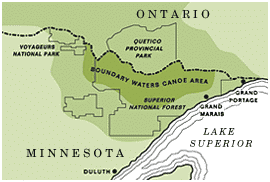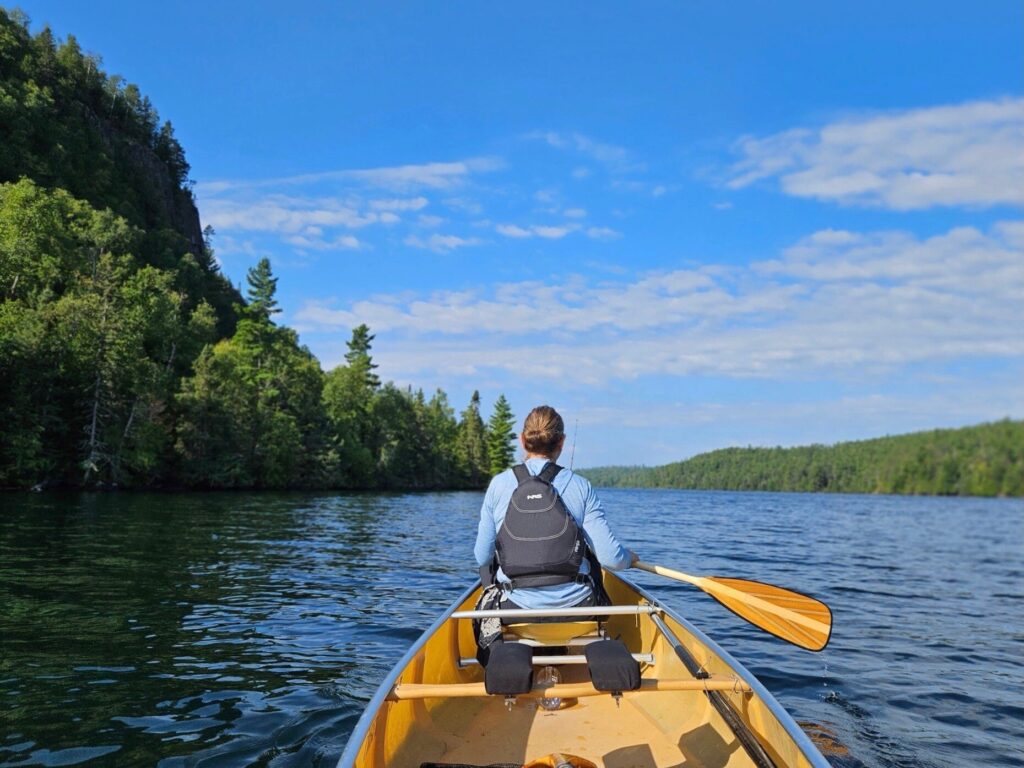
“If we want to do a Boundary Waters trip this year, we need to plan it this week,” I proclaimed one evening as the days grew shorter and I sensed the end of summer in the air. Without hesitation, my spouse pulled up his calendar and found a three-week period when he had the flexibility to drop off the grid and disappear for a while. With such a small window for planning, I immediately jumped into action and pulled up Recreation.gov to browse available last-minute Boundary Waters Canoe Area (BWCA) permits.
My heart sank as I opened the calendar full of zeros, indicating that all available permits had been claimed by parties who planned ahead. But as I scrolled through, I began to feel more hopeful as random availability popped up. I pulled out my National Geographic Boundary Waters maps that cover the entire BWCA on two reasonably sized maps. As I came across available permits, I looked at the entry point on the map to see if we might be able to create a fun and interesting loop in the area. After looking at every day and entry point available during our three-week window, I had six solid options for a last-minute BWCA adventure.
I grabbed my notes, maps, and a calendar and sat down next to my husband to review our options. We quickly narrowed it down to two entry points that offered interesting route options in areas we hadn’t spent much time in. As we discussed different ideas, I said, “I’m really leaning toward North Fowl. I’ve always wanted to paddle that area, and this seems like the perfect opportunity.” He agreed, I booked the permit, and we were on our way to planning a last-minute Boundary Waters adventure we won’t soon forget.

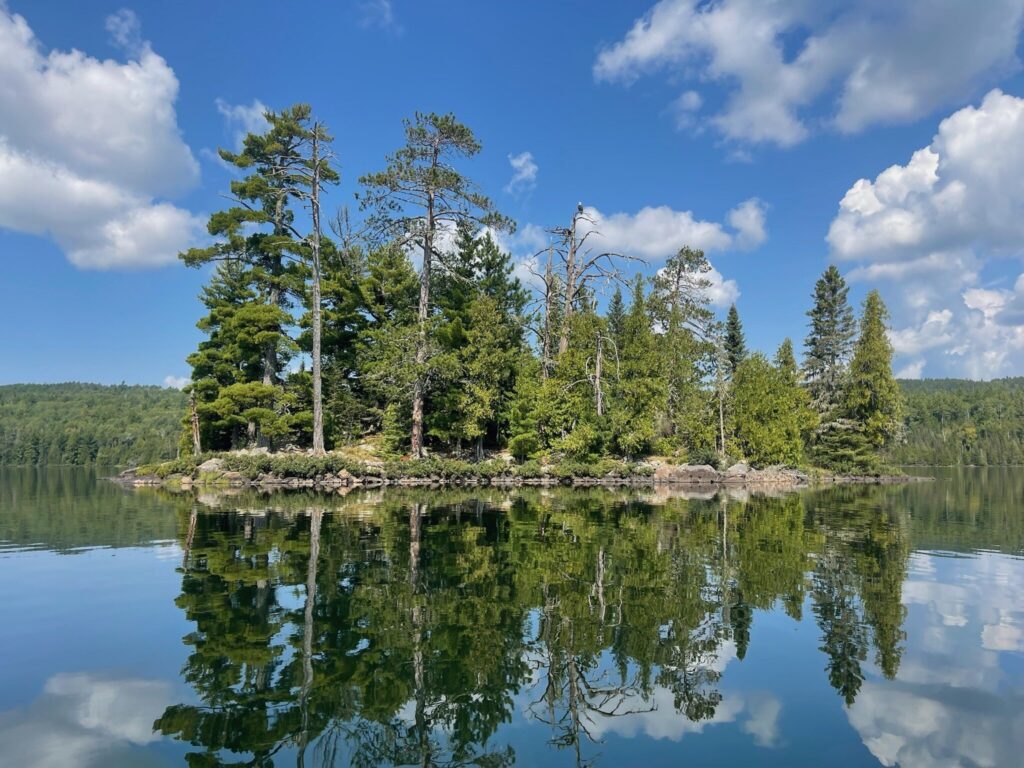
Planning a BWCA Trip
After finalizing plans to meet up with a friend during an upcoming fall trip, she said, “Look at that, you’ve got it all figured out, months ahead of schedule.” I laughed and said, “But I have nothing ready for our Boundary Waters trip next week.” “I feel like you’re probably a pro at the BWCA,” she replied. “I know a thing or two, but there’s a bit more planning and preparation that goes into backcountry trips,” I told her.
Planning our annual BWCA trip typically begins in January, before that year’s permits are released on the last Wednesday of the month. We move furniture and lay maps out on the floor so we can review the routes we’ve traveled and areas we have yet to explore. We read trip reports on BWCA.com, read lake surveys using the Minnesota DNR’s LakeFinder tool, and, when available, watch a YouTube video or two. By the time permit day comes around, we have a really good idea of where we’re going, when, and what we’ll see along the way. It’s a great escape during the coldest month of the year. But more than anything, it ensures we make our highly valued wilderness time happen each year.
We’ve enjoyed one long weekend BWCA base camping trip that you can read about here. But all of our other trips have been long loops that traversed dozens of lakes over a period of 10 to 16 days. At over one million acres, there’s a lot to see in the BWCA, and we’d like to see as much as possible. While we’ve learned to leave plenty of extra days to slow down, explore, fish, and stay put during rough weather, we also enjoy putting in some miles.
The Boundary Waters is one of the country’s most visited wilderness areas, and the high usage is visible, especially along the outer edge of the wilderness. With this in mind, we try to be intentional with our own usage. If we’re headed out for a long weekend to canoe, camp, and fish, we prefer to use the Superior National Forest and other recreation spots in the area. The added bonus is that outside of the wilderness, no permits are required, making last-minute trips quick and easy. That said, the wilderness is a special place with a feel of its own. As we grow older, I’m sure we’ll change how we use this priceless public land.
If planning a BWCA trip is new to you, pay special attention to the following tips. My spouse and I tend to err on the side of having everything figured out before we jump into something new—like traveling in the Boundary Waters Wilderness. While this has served us well in many ways, we both question whether we should have leaped sooner. If you’re on this fence too, here are some resources that will help you.
Planning Resources
Overnight access to the Boundary Waters Canoe Area Wilderness requires a permit for a specific entry point. You may only enter the wilderness at that entry point on that day, and you may not reenter the wilderness after exiting. So, you’ll want to consider your options carefully before booking.
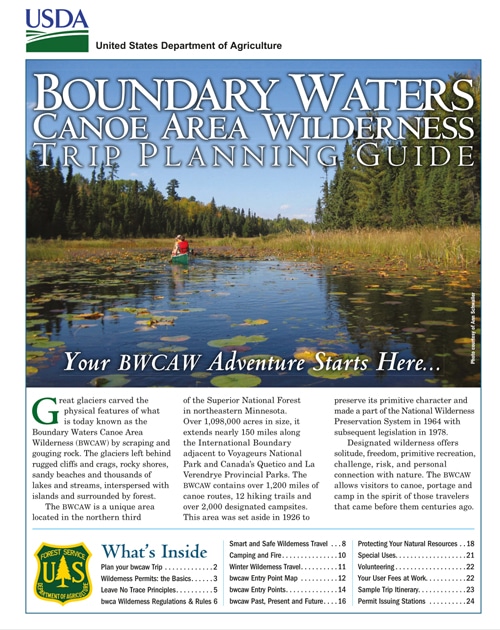
Outfitters are a great place to start for anyone new to the Boundary Waters and canoe tripping. BWCA.com has a comprehensive list of outfitters that will help you find the right partner for your trip.
Next, I recommend reading the entire 22-page Boundary Waters Canoe Area Wilderness Trip Planning Guide from the US Forest Service. It’s short, easy, and enjoyable to read. And knowing how to plan and what to expect will ensure your trip is safe, fun, and memorable.
Before choosing your entry point and route, check out these 10 questions to ask before booking your permit. It will help you determine what kind of trip you want to plan, how far you want to travel, and what you need to prepare before you hit the water.
Paddle Planner is a great resource to help you plan routes and distances. I also have an iPhone app that works offline and allows me to trace routes and estimate mileage. Surprisingly, this seems to consistently be the most accurate. But you should never rely solely on technology. Always carry paper maps and a compass—bonus points if you carry one map (or copies) per person.
If you enjoy fishing, the aforementioned LakeFinder tool is great. But plan to pack in enough food for days with inclement weather and times when the fish aren’t biting. It’s easier to pack it out than not have enough.
Finally, as I work through this process, I always make detailed notes in my note app that also works offline. You’ll appreciate the effort when you’re in the middle of the wilderness, trying to remember which lake has the big lake trout. And I always reference previous years’ notes while planning.
What’s Great About Last-Minute BWCA Trips
There are many benefits to planning your BWCA trip in advance, like securing your preferred dates and entry points. But as we worked through preparing for this last-minute trip, I discovered several wonderful surprises in planning last minute.
When you’re planning a route in the middle of January, there’s no way of knowing what the water levels and weather will be like during the upcoming season. For example, there are river routes that I would never plan for late summer because the water levels are typically quite low. But this year, those routes would have been a breeze with the abundance of rain throughout the season.
Planning last-minute also allows you to explore entry points you wouldn’t have otherwise considered. While I’ve long known that the easternmost section of the Boundary Waters—often referred to as the Vento Unit—is a breathtaking place to paddle. I was also aware that if we ever traveled this route, we’d never be more than four hours from an entry point, and I falsely believed that we wouldn’t enjoy the same solitude we always look forward to. Now that the trip has passed, I couldn’t be more pleased with the level of solitude and how everything turned out.
Finally, the joy that comes from flexibility and spontaneity can’t be beat. I don’t have to tell you how quickly our short Minnesota summers fly by. I’ve missed several important events due to permits and reservations I didn’t want to cancel, and have canceled several amazing reservations due to events I couldn’t miss. As someone who’s naturally wired to be an organized planner, I’ve come to love the delightful surprises that come with being spontaneous. And less time planning means more time enjoying these summers that always feel a tad too short.

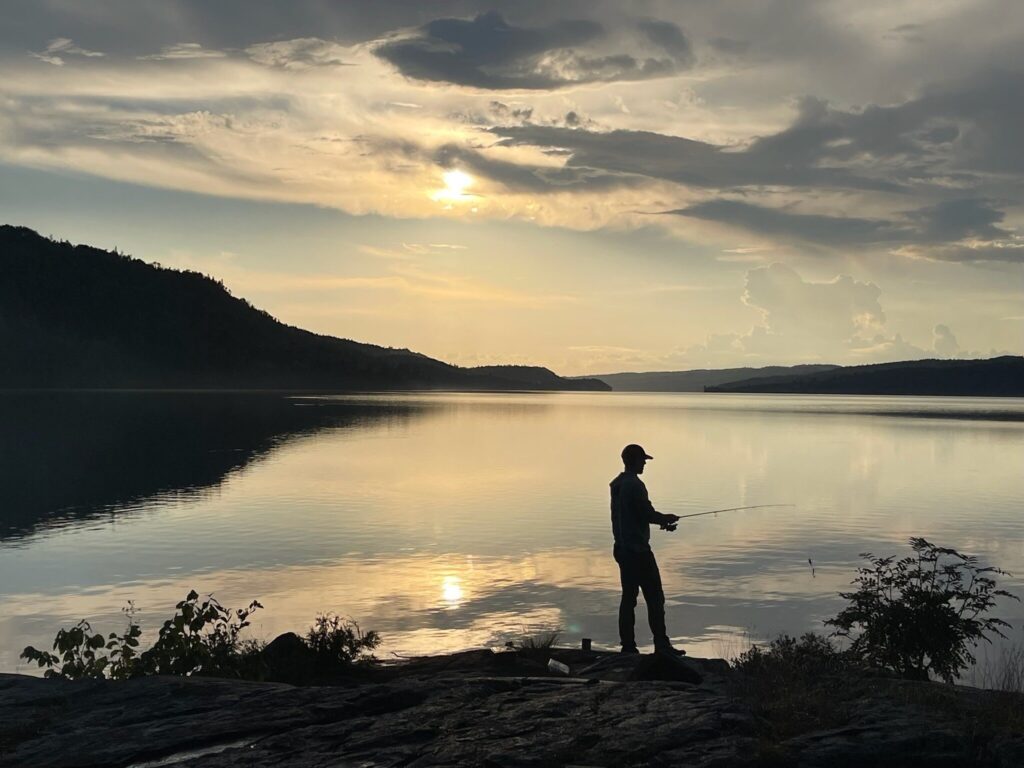
Helpful Tips for Last-Minute Trips
The previously mentioned resources are full of wonderful tips you may not have considered while planning a last-minute BWCA trip. Here are a few more of my personal best tips.
Know your limits. At this point in our lives, it’s easy for us to jump into almost any adventure and make it work. We’re active daily, and all of our leisure time is spent outdoors. This wasn’t always the case, though, so we started small, only attempting what we knew we could handle.
Invest in good maps. I don’t think I’ve written a backcountry story that hasn’t mentioned maps. I love maps and in my opinion they’re essential for planning and navigation. As long as we’ve been taking overnight trips to the BWCA, we’ve owned the National Geographic map bundle. I’ve used every brand of Boundary Waters maps and enjoy specific features of each. What I like about the National Geographic maps is that in just two maps, you get the entire BWCA, making them great for planning and as a backup when you’re on your trip. If you visit the BWCA often, the Voyageur Maps are wonderful as well. I purchased the 10-map set as a gift for my spouse, and we’ve enjoyed the added features like fishing information and portage difficulty ratings.
Organization is your friend. I’m wired for systems and organization. If this isn’t you, borrow someone else’s systems and keep them somewhere you can easily find them. I have master packing and planning lists that I duplicate and customize for every trip. I take notes before, during, and after each trip. And I have gear and supply organization down to a science. All of this makes it super easy to prepare for a trip in a limited amount of time.
While planning and preparing for backcountry trips can sometimes feel overwhelming and time-consuming, it doesn’t need to. By following these tips and tricks, you’ll be on your way to planning a BWCA trip you won’t soon forget.

Holly Scherer is a Minnesota-based writer, photographer, outdoorswoman, and guide. She’s most at home in the great outdoors; camping, hiking, paddling, cycling, and gardening. When she’s not on an adventure, she and her husband live in the Twin Cities where they’re fond of saying, “home is where we store our outdoor gear.”

